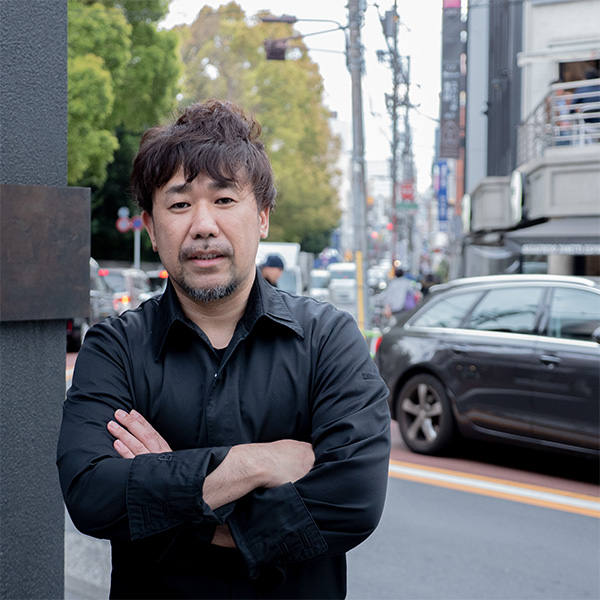Renowned chef Minoru Hasegawa opened two Italian restaurants in Hokkaido, launched a restaurant named “Hasegawa Minoru” in Hiroo, and has produced many more popular dining establishments in Tokyo. His exquisite and creative dishes are constantly attracting large numbers of foodies. He received the Future Great of the Year in the 2019 awards of French restaurant guide Gault & Millau, and continues to gain attention in Japan and abroad. In April 2023, he opened Hichou Kurata, a restaurant specializing in chicken, in Kanda, as well as Rou Hasegawa Minoru Lab, in Tokyu Kabukicho Tower, and shows no sign of stopping. We interviewed the “toast of the town,” supervising master chef Hasegawa, and Yuta Sato, owner of Hasegawa Minoru Group, to find out about the specialties of the new restaurants and about future projects.
Always offering new business styles for foodies from Japan and abroad

Could you tell us about your restaurant Hichou Kurata, which took part in the recent Delicious Museum?
Hasegawa: Many people think of chicken as a cheap food. But to raise them properly actually costs a lot of money. It’s a lot of work to raise each chicken carefully. But chicken still has the image of being a cheap meat. We want to serve meat from birds that have been meticulously raised, to introduce people to the delights of chicken. Ours is such a restaurant.
Tell us what’s most important to you about the chicken meat served at Hichou Kurata?
Hasegawa: Our company’s chicken farms are particular about their feed and environment, working hard to raise free-range birds, of which we use only the hens for meat.
One key point is that they are fattened slowly. Usually, mass-produced chickens (“broilers”) are raised for 40 – 50 days, and free-range chickens for about 90 days, but ours are raised for 240 days or more. Free-range chicken can have a tough texture, but the meat of slow-fattened hens is more tender. Naturally they are tougher than regular broilers, but not as much as typically chewy free-range chicken.
Also, the chicken fat is delicious. It has a low melting point and is highly aromatic. We specifically cook the chicken meat in its own fat on a hot plate to allow diners to savor this taste.
We serve steamed rice topped with a beaten egg as a final course, and also flavor this with chicken fat—our customers love it.
Why did you expand to Tokyo after opening restaurants in Chitose and Ebetsu cities (in Hokkaido)?
Hasegawa: Tokyo seemed like the quickest route to achieving my personal goals. Even when I lived in Hokkaido, I loved eating out in Tokyo, and I always compared the tastes and skills to my own cooking. I visited many famous establishments—then, one day, I thought “I could cook in Tokyo.” It might’ve sounded cocky, but I felt that what I’d achieved and the skills I’d gained compared favorably with Tokyo.
But when I first came here, I worked a whole year without a break. It was pretty tough. Thanks to the help of my staff, before we knew it, we had a lot of regular customers, and I sensed we were on the right track.
What kind of things interest you and what ingredients are you focusing on?
Hasegawa: I think our chicken is quite good. (laughs)
Sato: I’m delighted that our eggs always sell out, although it’s possibly affected by the current egg shortage.
At the moment, I’m interested in producing ingredients healthily, without chemicals.
We experimented in raising healthier broilers ourselves to see how they’d taste, and they were actually delicious. I think it’d be interesting in the future to focus on using such healthy ingredients at our restaurants to prepare more tasty dishes.
Of course, there is the question of how much people would appreciate it—that’s somewhat of a challenge. We also started test-raising pigs and sheep in a healthier way in Hokkaido.
What plans do you have in the pipeline at the moment?
Sato: We are preparing to build something like an auberge in Miyazaki to open at the end of next year.
In Tokyo, you can find delicacies from around Japan, but I also know there are foods you can only find regionally, tastes you can only enjoy in remote places.
There are restaurants all over Japan serving dishes you can only eat in their region. I think that’s special, as I said to begin with. That’s what I hope we can achieve in Miyazaki for a start.
We will source the best uniquely local ingredients and bring chefs from around Japan to cook for us, as well as offering accommodation. That’s the sort of thing I’d like to do more of.
Hasegawa: An other exciting development is the Hasegawa Minoru Lab that we recently opened in Tokyu Kabukicho Tower. We still haven’t started actively promoting it, so it’s hard to know how it will go, but I’ve heard that 50,000 people have already accessed the website. I’m now working at Kabukicho every day, so I’d love to see many people visit me there.




